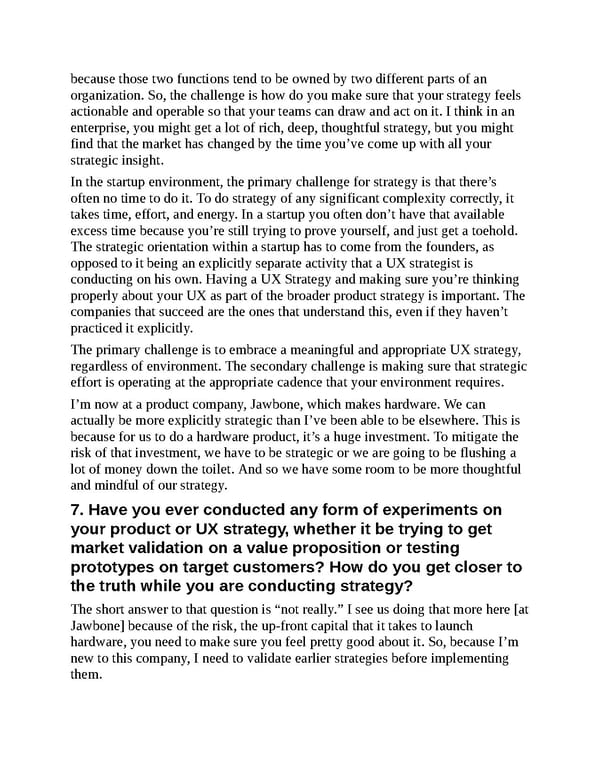because those two functions tend to be owned by two different parts of an organization. So, the challenge is how do you make sure that your strategy feels actionable and operable so that your teams can draw and act on it. I think in an enterprise, you might get a lot of rich, deep, thoughtful strategy, but you might find that the market has changed by the time you’ve come up with all your strategic insight. In the startup environment, the primary challenge for strategy is that there’s often no time to do it. To do strategy of any significant complexity correctly, it takes time, effort, and energy. In a startup you often don’t have that available excess time because you’re still trying to prove yourself, and just get a toehold. The strategic orientation within a startup has to come from the founders, as opposed to it being an explicitly separate activity that a UX strategist is conducting on his own. Having a UX Strategy and making sure you’re thinking properly about your UX as part of the broader product strategy is important. The companies that succeed are the ones that understand this, even if they haven’t practiced it explicitly. The primary challenge is to embrace a meaningful and appropriate UX strategy, regardless of environment. The secondary challenge is making sure that strategic effort is operating at the appropriate cadence that your environment requires. I’m now at a product company, Jawbone, which makes hardware. We can actually be more explicitly strategic than I’ve been able to be elsewhere. This is because for us to do a hardware product, it’s a huge investment. To mitigate the risk of that investment, we have to be strategic or we are going to be flushing a lot of money down the toilet. And so we have some room to be more thoughtful and mindful of our strategy. 7. Have you ever conducted any form of experiments on your product or UX strategy, whether it be trying to get market validation on a value proposition or testing prototypes on target customers? How do you get closer to the truth while you are conducting strategy? The short answer to that question is “not really.” I see us doing that more here [at Jawbone] because of the risk, the up-front capital that it takes to launch hardware, you need to make sure you feel pretty good about it. So, because I’m new to this company, I need to validate earlier strategies before implementing them.
 UX Strategy: How to Devise Innovative Digital Products that People Want Page 295 Page 297
UX Strategy: How to Devise Innovative Digital Products that People Want Page 295 Page 297